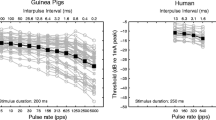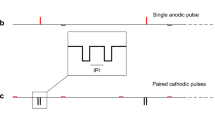Abstract
Previous cochlear implant studies using isolated electrical stimulus pulses in animal models have reported that intracochlear monopolar stimulus configurations elicit broad extents of neuronal activation within the central auditory system—much broader than the activation patterns produced by bipolar electrode pairs or acoustic tones. However, psychophysical and speech reception studies that use sustained pulse trains do not show clear performance differences for monopolar versus bipolar configurations. To test whether monopolar intracochlear stimulation can produce selective activation of the inferior colliculus, we measured activation widths along the tonotopic axis of the inferior colliculus for acoustic tones and 1,000-pulse/s electrical pulse trains in guinea pigs and cats. Electrical pulse trains were presented using an array of 6–12 stimulating electrodes distributed longitudinally on a space-filling silicone carrier positioned in the scala tympani of the cochlea. We found that for monopolar, bipolar, and acoustic stimuli, activation widths were significantly narrower for sustained responses than for the transient response to the stimulus onset. Furthermore, monopolar and bipolar stimuli elicited similar activation widths when compared at stimulus levels that produced similar peak spike rates. Surprisingly, we found that in guinea pigs, monopolar and bipolar stimuli produced narrower sustained activation than 60 dB sound pressure level acoustic tones when compared at stimulus levels that produced similar peak spike rates. Therefore, we conclude that intracochlear electrical stimulation using monopolar pulse trains can produce activation patterns that are at least as selective as bipolar or acoustic stimulation.















Similar content being viewed by others
References
Aitkin L, Tran L, Syka J (1994) The responses of neurons in subdivisions of the inferior colliculus of cats to tonal, noise and vocal stimuli. Exp Brain Res 98:53–64
Bierer JA (2007) Threshold and channel interaction in cochlear implant users: evaluation of the tripolar electrode configuration. J Acoust Soc Am 121:1642–1653
Bierer JA, Middlebrooks JC (2002) Auditory cortical images of cochlear-implant stimuli: dependence on electrode configuration. J Neurophysiol 87:478–492
Bierer JA, Bierer SM, Middlebrooks JC (2010) Partial tripolar cochlear implant stimulation: spread of excitation and forward masking in the inferior colliculus. Hear Res 270:134–142
Boex C, Kos MI, Pelizzone M (2003a) Forward masking in different cochlear implant systems. J Acoust Soc Am 114:2058–2065
Boex C, de Balthasar C, Kos MI, Pelizzone M (2003b) Electrical field interactions in different cochlear implant systems. J Acoust Soc Am 114:2049–2057
Boex C, Baud L, Cosendai G, Sigrist A, Kos MI, Pelizzone M (2006) Acoustic to electric pitch comparisons in cochlear implant subjects with residual hearing. J Assoc Res Otolaryngol 7:110–124
Bonham BH, Litvak LM (2008) Current focusing and steering: modeling, physiology, and psychophysics. Hear Res 242:141–153
Chen Z, Hu G, Glasberg BR, Moore BC (2011) A new method of calculating auditory excitation patterns and loudness for steady sounds. Hear Res 2011:10
Cohen LT, Saunders E, Clark GM (2001) Psychophysics of a prototype peri-modiolar cochlear implant electrode array. Hear Res 155:63–81
Dean I, Harper NS, McAlpine D (2005) Neural population coding of sound level adapts to stimulus statistics. Nat Neurosci 8:1684–1689
Egorova M, Ehret G (2008) Tonotopy and inhibition in the midbrain inferior colliculus shape spectral resolution of sounds in neural critical bands. Eur J Neurosci 28:675–692
Ehret G, Merzenich MM (1988) Neuronal discharge rate is unsuitable for encoding sound intensity at the inferior-colliculus level. Hear Res 35:1–7
Finley CC, Holden TA, Holden LK, Whiting BR, Chole RA, Neely GJ, Hullar TE, Skinner MW (2008) Role of electrode placement as a contributor to variability in cochlear implant outcomes. Otol Neurotol 29:920–928
Friesen LM, Shannon RV, Cruz RJ (2005) Effects of stimulation rate on speech recognition with cochlear implants. Audiol Neurootol 10:169–184
Harris DM, Shannon RV, Snyder R, Carney E (1997) Multi-unit mapping of acoustic stimuli in gerbil inferior colliculus. Hear Res 108:145–156
Kileny PR, Zwolan TA, Telian SA, Boerst A (1998) Performance with the 20 + 2 L lateral wall cochlear implant. Am J Otol 19:313–319
Kral A, Hartmann R, Mortazavi D, Klinke R (1998) Spatial resolution of cochlear implants: the electrical field and excitation of auditory afferents. Hear Res 121:11–28
Kwon BJ, van den Honert C (2006) Effect of electrode configuration on psychophysical forward masking in cochlear implant listeners. J Acoust Soc Am 119:2994–3002
Leake PA, Hradek GT, Snyder RL (1999) Chronic electrical stimulation by a cochlear implant promotes survival of spiral ganglion neurons after neonatal deafness. J Comp Neurol 412:543–562
Lee CF, Li GJ, Wan SY, Lee WJ, Tzen KY, Chen CH, Song YL, Chou YF, Chen YS, Liu TC (2010) Registration of micro-computed tomography and histological images of the guinea pig cochlea to construct an ear model using an iterative closest point algorithm. Ann Biomed Eng 38:1719–1727
Liang DH, Lusted HS, White RL (1999) The nerve-electrode interface of the cochlear implant: current spread. IEEE Trans Biomed Eng 46:35–43
Liberman MC (1982) The cochlear frequency map for the cat: labeling auditory-nerve fibers of known characteristic frequency. J Acoust Soc Am 72:1441–1449
Merzenich MM, White MW (1977) Cochlear implant: the interface problem. In: Hambrecht FT, Reswich JB (eds) Functional electrical stimulation: applications in neural prosthesis. Dekker, New York, pp 321–340
Middlebrooks JC (2004) Effects of cochlear-implant pulse rate and inter-channel timing on channel interactions and thresholds. J Acoust Soc Am 116:452–468
Middlebrooks JC (2008) Auditory cortex phase locking to amplitude-modulated cochlear implant pulse trains. J Neurophysiol 100:76–91
Middlebrooks JC, Snyder RL (2007) Auditory prosthesis with a penetrating nerve array. J Assoc Res Otolaryngol 8(2):258–279
Middlebrooks JC, Snyder RL (2008) Intraneural stimulation for auditory prosthesis: modiolar trunk and intracranial stimulation sites. Hear Res 242:52–63
Morris DJ, Pfingst BE (2000) Effects of electrode configuration and stimulus level on rate and level discrimination with cochlear implants. J Assoc Res Otolaryngol 1:211–223
Nelson DA, Donaldson GS, Kreft H (2008) Forward-masked spatial tuning curves in cochlear implant users. J Acoust Soc Am 123:1522–1543
Nuding SC, Chen GD, Sinex DG (1999) Monaural response properties of single neurons in the chinchilla inferior colliculus. Hear Res 131:89–106
Pfingst BE, Franck KH, Xu L, Bauer EM, Zwolan TA (2001) Effects of electrode configuration and place of stimulation on speech perception with cochlear prostheses. J Assoc Res Otolaryngol 2:87–103
Ramachandran R, Davis KA, May BJ (1999) Single-unit responses in the inferior colliculus of decerebrate cats. I. Classification based on frequency response maps. J Neurophysiol 82:152–163
Rebscher SJ, Snyder RL, Leake PA (2001) The effect of electrode configuration and duration of deafness on threshold and selectivity of responses to intracochlear electrical stimulation. J Acoust Soc Am 109:2035–2048
Rebscher SJ, Hetherington AM, Snyder RL, Leake PA, Bonham BH (2007) Design and fabrication of multichannel cochlear implants for animal research. J Neurosci Methods 166:1–12
Relkin EM, Doucet JR (1997) Is loudness simply proportional to the auditory nerve spike count? J Acoust Soc Am 101:2735–2740
Rose JE, Greenwood DD, Goldberg JM, Hind JE (1963) Some discharge characteristics of single neurons in the inferior colliculus of the cat. I. Tonotopical organization, relation of spike counts to tone intensity and firing patterns of single elements. J Neurophysiol 26:294–320
Ryan AF, Miller JM, Wang ZX, Woolf NK (1990) Spatial distribution of neural activity evoked by electrical stimulation of the cochlea. Hear Res 50:57–70
Schoenecker MC, Bonham BH (2008) Fast stimulus artifact recovery in a multichannel neural recording system. In: Proceedings of the IEEE Biomedical Circuits and Systems Conference, pp 253–256.
Schreiner CE, Langner G (1997) Laminar fine structure of frequency organization in auditory midbrain. Nature 388:383–386
Schreiner CE, Raggio MW (1996) Neuronal responses in cat primary auditory cortex to electrical cochlear stimulation. II. Repetition rate coding. J Neurophysiol 75:1283–1300
Seshagiri CV, Delgutte B (2007) Response properties of neighboring neurons in the auditory midbrain for pure-tone stimulation: a tetrode study. J Neurophysiol 98:2058–2073
Shamma SA, Fleshman JW, Wiser PR, Versnel H (1993) Organization of response areas in ferret primary auditory cortex. J Neurophysiol 69:367–383
Shannon RV (1983a) Multichannel electrical stimulation of the auditory nerve in man. I. Basic psychophysics. Hear Res 11:157–189
Shannon RV (1983b) Multichannel electrical stimulation of the auditory nerve in man. II. Channel interaction. Hear Res 12:1–16
Smith ZM, Delgutte B (2007) Using evoked potentials to match interaural electrode pairs with bilateral cochlear implants. J Assoc Res Otolaryngol 8:134–151
Snyder RL, Bonham BH (2007) Responses of Inferior Colliculus Neurons to SAM Tones and Electrical Pulse Trains. In: Thirtieth Annual Midwinter Research Meeting of the Association for Research in Otolaryngology (Santi PA, ed), p 219. Denver, Colorado, USA
Snyder RL, Rebscher SJ, Cao KL, Leake PA, Kelly K (1990) Chronic intracochlear electrical stimulation in the neonatally deafened cat. I: Expansion of central representation. Hear Res 50:7–33
Snyder RL, Bierer JA, Middlebrooks JC (2004) Topographic spread of inferior colliculus activation in response to acoustic and intracochlear electric stimulation. J Assoc Res Otolaryngol 5:305–322
Snyder RL, Middlebrooks JC, Bonham BH (2008) Cochlear implant electrode configuration effects on activation threshold and tonotopic selectivity. Hear Res 235:23–38
Stickney GS, Loizou PC, Mishra LN, Assmann PF, Shannon RV, Opie JM (2006) Effects of electrode design and configuration on channel interactions. Hear Res 211:33–45
van den Honert C, Stypulkowski PH (1987) Single fiber mapping of spatial excitation patterns in the electrically stimulated auditory nerve. Hear Res 29:195–206
Wang X, Lu T, Snider RK, Liang L (2005) Sustained firing in auditory cortex evoked by preferred stimuli. Nature 435:341–346
Young ED (2003) Cochlear nucleus. In: Shepherd GM (ed) The synaptic organization of the brain, 5th edn. Oxford University Press, New York
Zwolan TA, Kileny PR, Ashbaugh C, Telian SA (1996) Patient performance with the Cochlear Corporation "20 + 2" implant: bipolar versus monopolar activation. Am J Otol 17:717–723
Acknowledgments
The authors thank Alex Hetherington and Steve Rebscher for construction of intracochlear electrodes and for assisting with data collection. This work was funded by NIH Predoctoral Fellowship 1 F31 DC008940-01A1, NIH/NIDCD HHS-N-263-2007-00054-C, the Epstein Fund, and Hearing Research, Inc.
Author information
Authors and Affiliations
Corresponding author
Appendix: chronically deafened cats
Appendix: chronically deafened cats
Six of the eight cats in this study were deafened as neonates by daily subcutaneous injections of neomycin sulfate (60 mg/kg; Leake et al. 1999) and received varying electrical stimulation regimes and drug treatments (Table 2). For all six animals, neomycin injections were started at day 1 after birth; click-evoked auditory brainstem responses were used to monitor hearing loss beginning after 16 days of treatment, at 2–3 days intervals. Neomycin treatment was discontinued after 16–21 injections when absence of responses to clicks at 90 dB SPL indicated a profound hearing loss. All six cats were implanted unilaterally at 4–7 weeks of age with an intracochlear electrode with six to eight stimulating contacts. Four cats also received a subcutaneous mini osmotic pump (Rebscher et al. 2007) for direct infusion of brain-derived neurotrophic factor (BDNF, 94 μg/ml, three animals) or artificial perilymph (one animal) into the inner ear. One animal received systemic treatment with rasagiline (1 mg/kg daily). Five cats also chronic electrical stimulation for 4 h per day, 5 days a week, for a period of 13–23 weeks. Four of these five animals received electrical stimulation with biphasic pulse trains (90 μs/phase) delivered by a Clarion™ CII speech processor. Levels of stimulation were controlled by the loudness of environmental sounds with maximum stimulation levels set at 6 dB above electrically evoked ABR thresholds, but no more than 500 μA. The remaining animal was stimulated with continuous trains of charge-balanced biphasic pulses (200 μs/phase) delivered at 300 pulses/s with 30-Hz sinusoidal amplitude modulation (100 % modulation depth). In this animal peak stimulation levels were set at 2 dB above electrically evoked ABR thresholds. Chronically deafened cats were studied in acute physiological experiments immediately following completion of the electrical stimulation and drug treatment protocols. Because the effect of treatment group was not significant for any of the tests performed (p > 0.09), data from all the cats were pooled.
Rights and permissions
About this article
Cite this article
Schoenecker, M.C., Bonham, B.H., Stakhovskaya, O.A. et al. Monopolar Intracochlear Pulse Trains Selectively Activate the Inferior Colliculus. JARO 13, 655–672 (2012). https://doi.org/10.1007/s10162-012-0333-4
Received:
Accepted:
Published:
Issue Date:
DOI: https://doi.org/10.1007/s10162-012-0333-4




